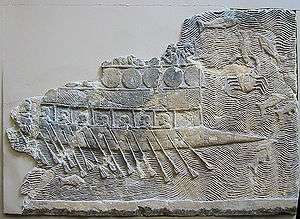Warship
.jpg)
A warship is a naval ship that is built and primarily intended for naval warfare. Usually they belong to the armed forces of a state.[1] As well as being armed, warships are designed to withstand damage and are usually faster and more maneuverable than merchant ships. Unlike a merchant ship, which carries cargo, a warship typically carries only weapons, ammunition and supplies for its crew. Warships usually belong to a navy, though they have also been operated by individuals, cooperatives and corporations.
In wartime, the distinction between warships and merchant ships is often blurred. In war, merchant ships are often armed and used as auxiliary warships, such as the Q-ships of the First World War and the armed merchant cruisers of the Second World War. Until the 17th century it was common for merchant ships to be pressed into naval service and not unusual for more than half a fleet to be composed of merchant ships. Until the threat of piracy subsided in the 19th century, it was normal practice to arm larger merchant ships such as galleons. Warships have also often been used as troop carriers or supply ships, such as by the French Navy in the 18th century or the Japanese Navy during the Second World War.
Evolution of warships
In the time of Mesopotamia, Ancient Persia, Ancient Greece and the Roman Empire, warships were always galleys (such as biremes, triremes and quinqueremes): long, narrow vessels powered by banks of oarsmen and designed to ram and sink enemy vessels, or to engage them bow-first and follow up with boarding parties. The development of catapults in the 4th century BC and the subsequent refinement of this technology enabled the first fleets of artillery-equipped warships by the Hellenistic age. During late antiquity, ramming fell out of use and the galley tactics against other ships used during the Middle Ages until the late 16th century focused on boarding.
The Age of Sail

Naval artillery was redeveloped in the 14th century, but cannon did not become common at sea until the guns were capable of being reloaded quickly enough to be reused in the same battle. The size of a ship required to carry a large number of cannons made oar-based propulsion impossible, and warships came to rely primarily on sails. The sailing man-of-war emerged during the 16th century.
By the middle of the 17th century, warships were carrying increasing numbers of cannon on their broadsides and tactics evolved to bring each ship's firepower to bear in a line of battle. The man-of-war now evolved into the ship of the line. In the 18th century, the frigate and sloop-of-war – too small to stand in the line of battle – evolved to convoy trade, scout for enemy ships and blockade enemy coasts.
Steel, steam and shellfire
During the 19th century a revolution took place in the means of marine propulsion, naval armament and construction of warships. Marine steam engines were introduced, at first as an auxiliary force, in the second quarter of the 19th century.
The Crimean War gave a great stimulus to the development of guns. The introduction of explosive shells soon led to the introduction of iron, and later steel, armour for the sides and decks of larger warships. The first ironclad warships, the French Gloire and British Warrior, made wooden vessels obsolete. Metal soon entirely replaced wood as the main material for warship construction.
From the 1850s, the sailing ships of the line were replaced by steam-powered battleships, while the sailing frigates were replaced by steam-powered cruisers. The armament of warships also changed with the invention of the rotating barbettes and turrets, which allowed the guns to be aimed independently of the direction of the ship and allowed a smaller number of larger guns to be carried.
The final innovation during the 19th century was the development of the torpedo and development of the torpedo boat. Small, fast torpedo boats seemed to offer an alternative to building expensive fleets of battleships.
The Dreadnought era

Another revolution in warship design began shortly after the start of the 20th century, when Britain launched the all-big-gun battleship Dreadnought in 1906. Powered by steam turbines, she was bigger, faster and more heavily gunned than any existing battleships, which she immediately rendered obsolete. She was rapidly followed by similar ships in other countries.
Britain also developed the first battlecruisers. Mounting the same heavy guns as the Dreadnoughts on an even larger hull, battlecruisers sacrificed armour protection for speed. Battlecruisers were faster and more powerful than all existing cruisers, which they made obsolete, but battlecruisers proved to be much more vulnerable than contemporary battleships.
The torpedo-boat destroyer was developed at the same time as the Dreadnoughts. Bigger, faster and more heavily gunned than the torpedo boat, the destroyer evolved to protect the capital ships from the menace of the torpedo boat.
Second World War
During the lead-up to the Second World War, Germany and Great Britain once again emerged as the two dominant Atlantic sea powers. Germany, under the Treaty of Versailles, had its navy limited to only a few minor surface ships. But the clever use of deceptive terminology, such as "Panzerschiffe" deceived the British and French commands. They were rudely surprised when ships such as the Admiral Graf Spee, Scharnhorst, and Gneisenau constantly raided the Allied supply lines. The greatest threat though, was the introduction of the Kriegsmarine's most lethal weapons, the Bismarck and Tirpitz. The Bismarck was damaged heavily in a series of sea battles in the north Atlantic in 1941, while the Tirpitz was destroyed by the Royal Air Force in 1944. The British Royal Navy gained dominance of the European theatre by 1943.

The Second World War brought massive changes in the design and role of several types of warships. For the first time, the aircraft carrier became the clear choice to serve as the main capital ship within a naval task force. World War II was the only war in history in which battles occurred between groups of carriers. World War II saw the first use of radar in combat. It brought the first naval battle in which the ships of both sides never engaged in direct combat, instead sending aircraft to make the attacks, in the Battle of Coral Sea.
Development of the submarine
The first practical submarines were developed in the late 19th century, but it was only after the development of the torpedo that submarines became truly dangerous (and hence useful). By the end of the First World War submarines had proved their potential. During the Second World War Nazi Germany's submarine fleet of U-boats almost starved Britain into submission and inflicted huge losses on US coastal shipping. The success of submarines led to the development of new anti-submarine convoy escorts during the First and Second World Wars, such as the destroyer escort. Confusingly, many of these new types adopted the names of the smaller warships from the age of sail, such as corvette, sloop and frigate.
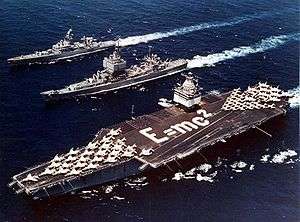

Development of the aircraft carrier
A major shift in naval warfare occurred with the introduction of the aircraft carrier. First at Taranto and then at Pearl Harbor, the aircraft carrier demonstrated its ability to strike decisively at enemy ships out of sight and range of surface vessels. By the end of the Second World War, the carrier had become the dominant warship.
Modern warships
Modern warships are generally divided into seven main categories, which are: aircraft carriers, cruisers, destroyers, frigates, corvettes, submarines and amphibious assault ships. Battleships comprise an eighth category, but are not in current service with any navy in the world. Only the deactivated American Iowa-class battleships still exist as potential combatants, and battleships in general are unlikely to re-emerge as a ship class without redefinition. The destroyer is generally regarded as the dominant surface-combat vessel of most modern blue-water navies. However, the once distinct roles and appearances of cruisers, destroyers, frigates, and corvettes have blurred. Most vessels have come to be armed with a mix of anti-surface, anti-submarine and anti-aircraft weapons. Class designations no longer reliably indicate a displacement hierarchy, and the size of all vessel types has grown beyond the definitions used earlier in the 20th century. Another key differentiation between older and modern vessels is that all modern warships are "soft", without the thick armor and bulging anti-torpedo protection of World War II and older designs.
Most navies also include many types of support and auxiliary vessels, such as minesweepers, patrol boats and offshore patrol vessels.
By 1982 the United Nations Convention on the Law of the Sea (UNCLOS) treaty negotiations had produced a legal definition of what was then generally accepted as a late-twentieth century warship. The UNCLOS definition was : "A warship means a ship belonging to the armed forces of a State bearing the external marks distinguishing such ships of its nationality, under the command of an officer duly commissioned by the government of the State and whose name appears in the appropriate service list or its equivalent, and manned by a crew which is under regular armed forces discipline."[1]
Types of warship
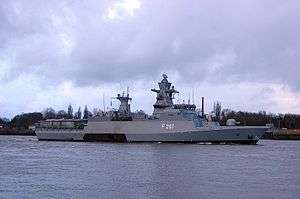
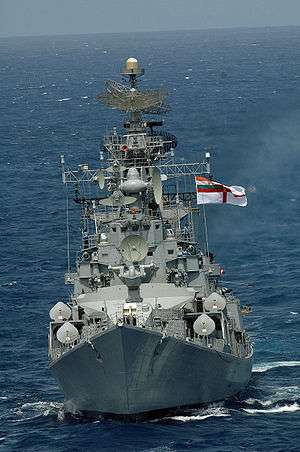
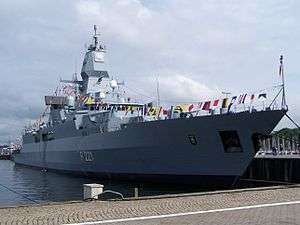
- Amphibious assault ship
- Aviso, a kind of dispatch boat
- Capital ship, the largest and most important ships in a nation's fleet. These were previously battleships, battlecruisers, and aircraft carriers, but the first two warship types are now no longer used.
- Aircraft carrier, a warship primarily armed with Carrier-based aircraft.
- Battlecruiser, a ship with battleship-level armament and cruiser-level armor; typically faster than a battleship because the reduction in armor allowed mounting of more powerful propulsion machinery, or the use of a more slender hull shape with a lower drag coefficient.
- Battleship, a large, heavily armoured warship equipped with many powerful guns. A term which generally post-dates sailing warships.
- Ironclad battleship, battleships built before the Pre-dreadnought in the 1870s and 1880s
- Pre-dreadnought battleship, sea-going battleships built to a common design before the launch the Dreadnoughts, between the mid- 1880s and 1905. Pre-dreadnoughts commonly featured a mixed main battery composed of several different caliber guns.
- Dreadnought, an early 20th-century battleship, which set the pattern for all subsequent battleship construction. Dreadnoughts differ from Pre-dreadnoughts in that they feature an all-big-gun main battery. The advantage lies in that if all the big guns have the same characteristics, only one firing solution will be needed to aim them all.
- Bireme, an ancient vessel, propelled by two banks of oars.
- Coastal defence ship, a warship built for the purpose of coastal defence.
- Commerce raider, any armed vessel—privately or government-owned—sanctioned to raid a nation's merchant fleet.
- Corvette, originally a small, lightly armed ship ordered by Winston Churchill, prime minister of Great Britain at the start of WW2. Corvette design was based on a commercial whale catcher, its primary attribute being ease of construction as an emergency wartime anti-submarine weapon. Its original engine was a reciprocating steam engine, original armament was one four inch gun, small arms and depth charges. Primary users of the WW2 corvette were the British Royal Navy and the Royal Canadian Navy, although corvettes saw use elsewhere.
- Cruiser, a fast, independent warship. Traditionally, cruisers were the smallest warships capable of independent action. Along with battleships and battlecruisers, they have largely vanished from modern navies.
- Destroyer, a fast and highly maneuverable warship, traditionally incapable of independent action. Originally developed to counter the threat of torpedo boats, they are now the largest independent warship generally seen on the ocean.
- Fast attack craft
- Fire ship, a vessel of any sort set on fire and sent into an anchorage or fleet with the intention of causing destruction and chaos. Exploding fire ships may be called hellburners.
- Frigate, a ship used in modern navies (Although they date back to the 17th century) that are typically used to protect merchant vessels and other warships.
- Galleass, a sailing and rowing warship, equally well suited to sailing and rowing.
- Galleon, a 16th-century sailing warship.
- Galley, a warship propelled by oars with a sail for use in favourable winds.
- Guided missile destroyer
- Gunboat
- Helicopter carrier, an aircraft carrier especially suited to helicopters and amphibious assault.
- Ironclad, a wooden warship with external iron plating.
- Longship, a Viking raiding ship.
- Man-of-war, a British Navy expression for a sailing warship.
- Minesweeper
- Minehunter
- Minelayer
- Missile boat
- Monitor, a small, heavily gunned warship with shallow draft designed for land bombardment.
- Naval trawler
- Naval drifter
- Offshore patrol vessel
- Quinquereme, an ancient warship propelled by three banks of oars. On the upper row, two rowers hold one oar; on the middle row, two rowers; and on the lower row, one man to an oar.
- Ship of the line, a sailing warship capable of standing in the line of battle. A direct predecessor to the later battleship.
- Sloop
- Submarine, a ship capable of remaining underwater for extended periods. Submarines in the world wars could stay under for less than a day, but development of nuclear reactors and air-independent propulsion allows submarines to stay submerged for weeks, even months at a time, with food supplies as the only limiting factor.
- Torpedo boat, a small, fast surface vessel designed for launching torpedoes.
- Trireme, an ancient warship propelled by three banks of oars.
See also
| Wikimedia Commons has media related to Naval ships. |
References
- 1 2 "United Nations Convention on the Law of the Sea. Part II, Subsection C". United Nations. Retrieved 28 June 2015.
